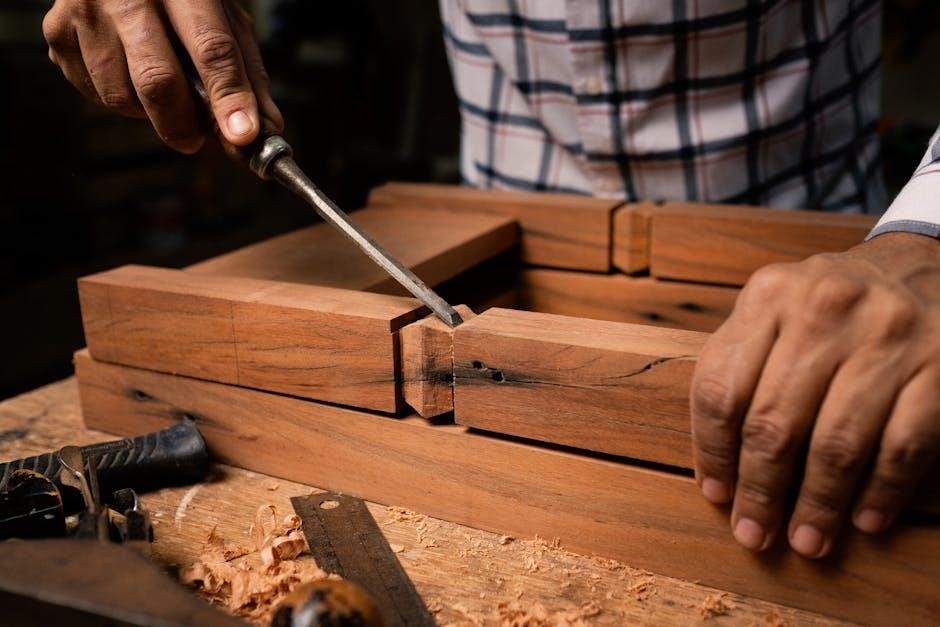dovetail guides

Dovetail guides are essential tools in woodworking, designed to help create precise dovetail joints. Their popularity has grown due to their ability to enhance accuracy and consistency. These guides eliminate human error, making it easier for both professionals and DIYers to achieve strong, attractive joints. They are a must-have for anyone aiming to master this classic woodworking technique.
What Are Dovetail Guides?
Dovetail guides are specialized woodworking tools designed to assist in cutting precise dovetail joints. They come in various forms, including saw guides and router jigs, each tailored to specific tasks. These guides help maintain the correct angle and alignment for cutting tails and pins, ensuring accurate and consistent results. Available in different slope ratios (1:5, 1:6, 1:8, 1:10), they cater to diverse project requirements. Whether for handmade sawing or machine-based routing, dovetail guides simplify the process, making it accessible for both beginners and professionals. Their ergonomic designs and robust construction ensure durability, while their adjustability allows for customization to suit different woodworking needs and preferences.
The Importance of Dovetail Guides in Woodworking
Dovetail guides play a crucial role in woodworking by ensuring precision and consistency in cutting dovetail joints. They eliminate the need for complex calculations and reduce human error, allowing woodworkers to achieve professional-grade results. These tools are particularly valuable for creating strong and visually appealing joints, essential for furniture-making and cabinetry. By maintaining the correct angles and alignment, dovetail guides enhance the structural integrity and aesthetic appeal of projects. They are indispensable for both beginners, who benefit from the guidance, and professionals, who rely on them for efficiency and accuracy. Their use has become a cornerstone in modern woodworking practices, enabling the creation of timeless, high-quality pieces with ease.

Types of Dovetail Guides
Dovetail guides come in various forms, including saw guides, router jigs, and adjustable templates. Each type offers unique benefits for different woodworking needs and preferences.
Dovetail Saw Guides
Dovetail saw guides are designed to hold a handsaw at a fixed angle, ensuring precise cuts for tails and pins. They keep the blade square to the wood’s face and edge, making it easier to achieve accurate joints. Popular among woodworkers, these guides come in different slope ratios, such as 1:5, 1:6, 1:8, and 1:10, allowing for various joint styles. Their ergonomic designs and durable construction make them indispensable for both beginners and professionals. By maintaining consistent angles, dovetail saw guides help woodworkers produce high-quality dovetail joints efficiently, enhancing both the appearance and strength of their projects.
Router Dovetail Jigs
Router dovetail jigs are specialized tools designed to help woodworkers create precise dovetail joints using a router. These jigs are highly efficient and offer exceptional accuracy, making them ideal for both professionals and hobbyists. They typically include a guide system and a specialized dovetail bit, allowing for consistent results. Router dovetail jigs are particularly useful for cutting multiple joints quickly and uniformly. Many models are adjustable, enabling users to customize the size and angle of the joints. They are especially popular for larger woodworking projects, where consistency and speed are crucial. With a router dovetail jig, achieving professional-grade joints becomes straightforward and time-efficient, making it a valuable addition to any woodworking shop.

How to Use Dovetail Guides
Using dovetail guides enhances accuracy and efficiency in creating precise dovetail joints. Start by aligning the guide with your workpiece, ensuring it is securely clamped. Adjust the guide to the desired slope ratio, such as 1:5 or 1:6, to match your project’s needs. Use the guide to steady your saw or router, maintaining consistent angle and alignment. Make controlled, steady cuts, first for the tails and then for the pins. Repeat as needed for multiple joints, ensuring each cut is precise and fits perfectly. This method ensures strong, professional-grade dovetail joints with minimal effort, making it ideal for both beginners and experienced woodworkers.
Step-by-Step Guide to Cutting Dovetail Joints
Start by setting the marking gauge to match the wood’s thickness. Mark the tail and pin locations on both pieces. Secure the dovetail guide to maintain the correct angle. Use a handsaw to cut the tails, keeping the blade aligned with the guide. After cutting the tails, flip or rotate the guide to cut the corresponding pins. Fit the tails and pins together to check the joint. Make minor adjustments if needed for a tighter fit. This method ensures accurate and strong dovetail joints, ideal for professional-grade woodworking projects.
Choosing the Right Dovetail Guide
Consider slope ratios, material quality, and ergonomic design when selecting a dovetail guide. Choose one that matches your project needs for precise, efficient results in woodworking.
Understanding Slope Ratios (1:5, 1:6, 1:8, 1:10)

Slope ratios in dovetail guides determine the angle of the joint, impacting strength and appearance. A 1:5 ratio offers a steep angle, ideal for thick woods and heavy-duty applications. The 1:6 ratio is a popular choice, providing a balanced angle suitable for most woodworking projects. For finer details and lighter materials, the 1:8 ratio is preferred, while the 1:10 ratio creates a subtle, elegant joint often used in cabinetry. Choosing the right slope ensures your dovetail joints are both functional and aesthetically pleasing, catering to specific project requirements and personal design preferences.

DIY Dovetail Guide
Create a custom dovetail guide using basic tools and materials. Cut wood pieces, align, and glue them to form the guide. Sand and test for precision before use.
Materials and Tools Needed

To make a custom dovetail guide, you’ll need straight-grained wood, such as maple or birch, for durability. Tools include a table saw or hand saw for precise cuts, sandpaper for smoothing edges, wood glue for assembly, and clamps to ensure alignment. A marking gauge or combination square is essential for accurate measurements. Optional items like a router or drill press can enhance the guide’s functionality. Ensure all materials are properly prepared and dry before assembly to guarantee a sturdy and reliable tool for cutting dovetail joints with consistency and precision.
Step-by-Step Instructions for Making a Custom Dovetail Guide
Begin by cutting your wood into two equal pieces and gluing them together to form the base of the guide. 2. Use a marking gauge to ensure accurate measurements for the dovetail angles. 3. Cut one side of the guide using a saw or router, following your desired slope ratio (e.g., 1:6 or 1:8). 4. Flip the guide and repeat the process for the opposite side to create symmetry. 5. Sand all edges for smoothness and assemble the pieces. 6. Test the guide by cutting a sample dovetail joint to ensure precision. This method allows for a customizable and reliable tool tailored to your woodworking needs.
Tips for Using Dovetail Guides Effectively
Use a marking gauge for precise measurements, ensure the guide is square to the wood, and maintain consistent pressure while cutting. Start with smaller projects to build confidence and gradually move to complex designs. Regularly inspect and clean the guide to prevent wear and tear. Ergonomic designs can reduce fatigue, allowing for longer woodworking sessions without discomfort. Always test the guide on scrap wood before working on your final piece to ensure accuracy and adjust as needed for optimal results.
Professional Woodworkers’ Advice
Professional woodworkers emphasize the importance of proper setup and calibration when using dovetail guides. Start by ensuring the guide is perfectly square to the wood and aligned with your saw or router. Always test the guide on scrap wood to confirm accuracy before cutting your final piece. Use the correct slope ratio for your project, as this ensures the joint’s strength and aesthetic appeal. Make small, incremental adjustments rather than trying to cut too much material at once. Keep the guide clean and well-maintained to prevent wear and tear. For hand sawing, use a consistent, gentle pressure and let the tool do the work. Experienced craftsmen like Father Michael Coffey highlight the value of patience and precision, as these small details make a significant difference in the final result. By following these tips, you can achieve professional-grade dovetail joints with ease and confidence.
Common Mistakes to Avoid
Common mistakes include incorrect guide setup, misalignment with the wood, and improper angle use. Always double-check your settings before cutting to ensure precise, professional results.

Pitfalls in Dovetail Joint Cutting
Cutting dovetail joints can be challenging due to improper alignment and angle mismanagement. A common issue is not maintaining the saw at the correct slope, leading to uneven joints. Misuse of guides can result in mismatched pins and tails, compromising the joint’s strength and appearance. Another pitfall is inadequate preparation of the wood, such as not marking accurately or failing to account for the material’s thickness. Additionally, applying too much pressure or cutting too aggressively can cause the saw to bind or veer off course. These mistakes highlight the importance of careful setup and precise technique to achieve flawless dovetail joints.
Dovetail guides are indispensable tools for achieving precise and professional dovetail joints. They enhance accuracy, consistency, and efficiency, making them a valuable asset for both professionals and hobbyists alike.
Final Thoughts on Dovetail Guides and Their Role in Woodworking
Dovetail guides have revolutionized the woodworking industry by offering precision and ease in creating dovetail joints. Their ergonomic designs and adjustable slopes cater to various woodworking needs, ensuring versatility. Whether for through dovetails or half-blinds, these guides simplify complex tasks, making them accessible to all skill levels. The ability to maintain a fixed angle and square alignment reduces errors, fostering confidence. As woodworking evolves, dovetail guides remain a cornerstone, enabling craftsmen to produce professional-grade results efficiently. Their impact is undeniable, solidifying their place as essential tools in every woodworker’s arsenal.





